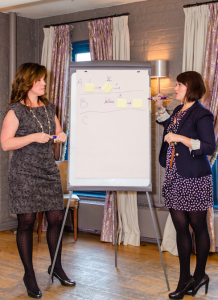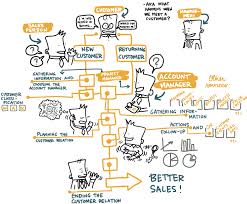Did you miss us? Ruth and I were saying that this is probably the longest we haven’t blogged. Don’t worry, we are back and in full force now!
In today’s blog I wanted to share some highlights of our 2-day course, “Leading Process Change,” which we delivered on November 5 & 6. We had a a great diverse group of participants, from the Ontario Government, Telus, Blackberry, and two web development firms, just to name a few. It was a total blast. We shared our experiences in change and leadership and learned basic process improvement skills too.
Day 1
On day 1 we whizzed through the Whiteboard Way. It was a lot of material to cover, and using a business case, we helped our team of participants to:
1. Define It – Define a specific problem in an organization, without assumptions, without solutions, and using specific data to isolate the issue.
2. Draw It – Use basic process mapping techniques to visually represent a process clearly.
3. Analyze It – Look for opportunities to improve (like bottlenecks, duplication, and roles & responsibility conflicts).
4. Imagine It – Imagine a future state using brainstorming techniques.
5. Prove It – Use data to ensure that the new process performs better than the original process.
6. Sell It – Use excellent communications and stakeholder engagement skills to ensure that the process change is communicated effectively.
Day 2
On day 2 we covered a wide range of leadership topics to help participants learn how to guide a change – from embedding process improvement within strategic plans, to using emotional intelligence to increase people’s buy-in, and even how public relations plays a role (care of our excellent guest speakers)! And as well we covered basic communication, relationship building, and change management skills too!
We were really pleased to get some great feedback from participants:
“Love it. I will definitely bring the knowledge back.”
“Great back and forth engagement.”
“Great idea to combine change (of any kind!) with leadership —> practical tools & advice in simple, accessible language. Love it.”
Now it’s on to new and exciting projects to come….what do you want to learn next?
Let us know on Twitter @whiteboardcons!
*Special thanks to our awesome photographer Sara Beasley @Sarabeesphotography, www.sarabeesphotography.com
Until Next Time,
Nicole




 A process can be defined as a series of actions or steps that are undertaken in order to achieve a particular outcome. Some common examples that may resonate with you – think of the steps that are involved in each:
A process can be defined as a series of actions or steps that are undertaken in order to achieve a particular outcome. Some common examples that may resonate with you – think of the steps that are involved in each: